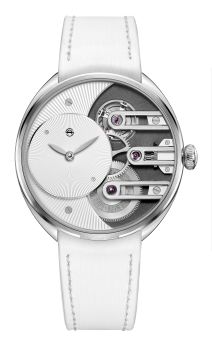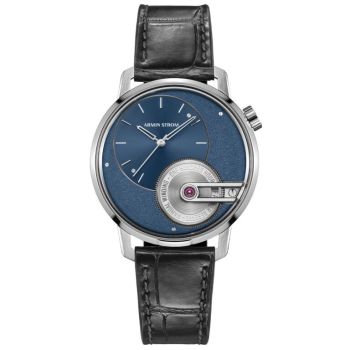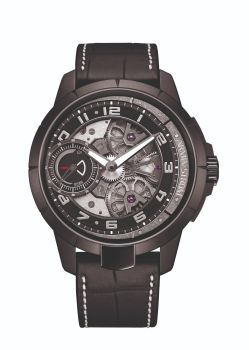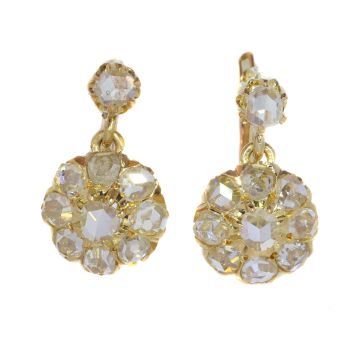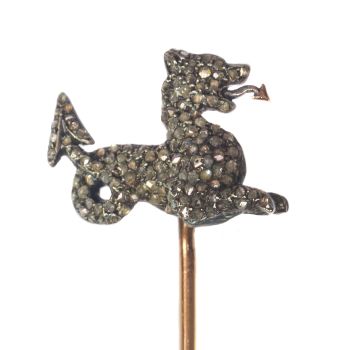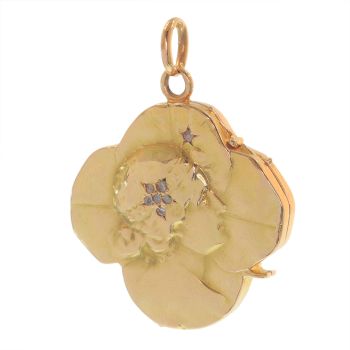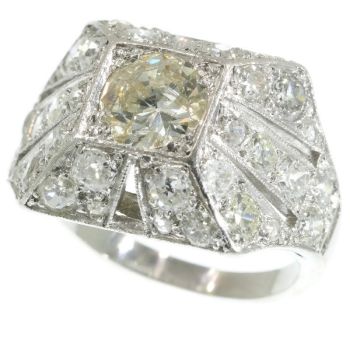Vintage Art Deco platinum ladies wrist watch made by Leon Hatot set with diamonds and sapphires 1920
Leon Hatot
diamantSaphirGemmePlatine
Actuellement indisponible via Gallerease
- Sur l'oeuvre d'art
Antique jewelry object group
ladies wrist watch
Condition
very good condition
more info on our condition scale
Country of origin
France
Style
Art Deco - Art Deco is an eclectic artistic and design style which had its origins in Paris in the first decades of the 20th century. The style originated in the 1920s and continued to be employed until after World War II. The term "art deco" first sawwide use after an exhibition in 1966, referring to the 1925 Exposition Internationale des Arts Décoratifs et Industriels Modernes that was the culmination of high-end style modern in Paris. Led by the best designers in the decorative arts such asfashion, and interior design, Art Deco affected all areas of design throughout the 1920s and 1930s, including architecture and industrial design, as well as the visual arts such as painting, the graphic arts and film. At the time, this style was seen aselegant, glamorous, functional and modern.
See also: Art Deco
more info on styles
Style specifics
Abstract motives and geometrical forms are quite typical for the Art Deco period. Art Deco moved away from the soft pastels and organic forms of its style predecessor, Art Nouveau, and embraced influences from many different styles and movements of the early 20th century, including Neoclassical, Constructivism, Cubism, Modernism,and Futurism. Its popularity peaked in Europe during the Roaring Twenties and continued strongly in the United States through the 1930s. Although many design movements have political or philosophical roots or intentions, Art Deco was purelydecorative.
Period
ca. 1920
Events & facts of this era, poetry of this era, fashion of this era.
Material
platinum (touchstone tested)
more info on precious metals
Extra information
Leon Hatot (1883-1953) Started in 1911, bought the atelier of Brédillard in Paris and was supplier to the important jewellery houses in quartier Vendôme and of René-Boivin.
Diamonds
Six old brilliant cut with an estimated weight of ± 0.48ct
112 single brilliant cut diamonds (also called 8/8)with an estimated weight of ± 2.00ct
Total diamond count
118 pcs.
Total diamond weight
approx. 2.48 crt with an average colour and clarity F/J, vs/i
All diamond weights, color grades and clarity are approximate since stones are not removed from their mounts to preserve the integrity of the setting.
All diamonds we offer are screened by the I.J.G.C. for whether they are natural or synthetic, and all diamonds in this jewel are 100% guaranteed to be natural.
Precious stones
48 sapphires
It is a very common practice to treat gemstones to intensify their clarity or colour. The item in question has not been tested in this regard.
Birthstones
Diamond is the birthstone (or month stone) for April and sapphire for September.
more info on birthstones
Hallmarks
Mastermark LH for Leon Hatot and the French control mark for platinum representing a dog's head that was in use in France from about 1912.
more info on hallmarks
Dimensions
width case 2,30 cm (0,91 inch)
see picture with a ruler in millimeters and inches
Weight
22,00 gram (14,15 dwt)
- Sur l'artiste
Léon Hatot (1883 – 1953) était un entrepreneur passionné : inventif, novateur et surtout progressiste. Un enfant de son temps en fait, fasciné par l'application des derniers matériaux et techniques.
L'entrepreneur et orfèvre Léon Hatot a fréquenté l'École d'Horlogerie de Besançon de 1895 à 1898 puis l'École des Beaux Arts, également à Besançon. Très jeune, il s'installe à Besançon en 1905 en tant qu'entrepreneur indépendant et se spécialise dans la gravure de boîtiers horlogers.
Il établit rapidement un atelier d'horlogers et de bijoutiers à Paris également. Ici, assisté d'un grand nombre d'artisans, il fabriquait des horloges de haute qualité, en utilisant des métaux précieux spéciaux. A cette époque, Hatot était l'un des rares à fabriquer des montres ainsi que des bijoux. Il les fournit aux plus importantes maisons de négoce de la rue de la Paix à Paris.
Curieux et tourné vers l'avenir, Hatot s'intéresse très vite à l'application de l'électricité dans l'horlogerie. En 1920, cela aboutit à la création d'un département de recherche et de développement de montres à piles. Depuis 1923, les horloges électriques Hatot sont commercialisées sous la marque ATO depuis les sites de Paris et de Besançon.
Dès leur apparition sur le marché, ces garde-temps connaissent un succès retentissant. Lors de l'Exposition internationale des arts décoratifs, Hatot a reçu un "Grand Prix" pour l'ensemble de son programme d'horloges électriques. La caractéristique de ses modèles était qu'ils étaient logés dans du marbre, du métal chromé, des bois raffinés ou des vitrines en verre travaillé des célèbres usines Lalique.
Grâce au design décoratif de ces garde-temps, Hatot est en mesure de se faire un nom dans le monde de l'horlogerie en tant que "maître de la période Art Déco". Sa contribution au monde scientifique est également grande. Grâce à son esprit créatif et visionnaire et à ses nombreuses inventions, Hatot réussit à porter les développements dans le domaine de l'horlogerie à un niveau supérieur jusque et y compris le deuxième quart du XXe siècle. La France l'a récompensé pour cela avec la plus haute distinction nationale, la «Légion d'Honneur».
En 1931, à l'Exposition coloniale de Paris, Léon Hatot présente une série d'horloges électriques compactes qui marquent le début d'une nouvelle génération de garde-temps décoratifs. Il a complètement rompu avec la tradition actuelle dans laquelle les boîtiers servaient de décoration et faisaient du garde-temps lui-même le point de mire. De cette façon, Hatot est devenu un pionnier pour une nouvelle tendance à la mode.
Artwork details
Related artworks
Onbekende Kunstenaar
Vroege Art Deco broche1920
Prijs op aanvraagAns Hemke-Kuilboer Juwelier & Antiquair
1 - 4 / 24Armin Strom
Armin Strom Lady Beat "Manufacture Edition White"2022 - 2023
Prijs op aanvraagHa-Juweliers
Armin Strom
Armin Strom Lady Beat "Manufacture Edition Black"2022 - 2023
Prijs op aanvraagHa-Juweliers
Armin Strom
Armin Strom "Gravity Equal Force Ultimate Sapphire"2022 - 2023
Prijs op aanvraagHa-Juweliers
Armin Strom
Armin Strom "Tribute 1 Stainless Steel Blue Dial"2022 - 2023
Prijs op aanvraagHa-Juweliers
Armin Strom
Armin Strom "Lady Beat Rosé Gold Mother of Pearl"2022 - 2023
Prijs op aanvraagHa-Juweliers
1 - 4 / 24- 1 - 4 / 24





































